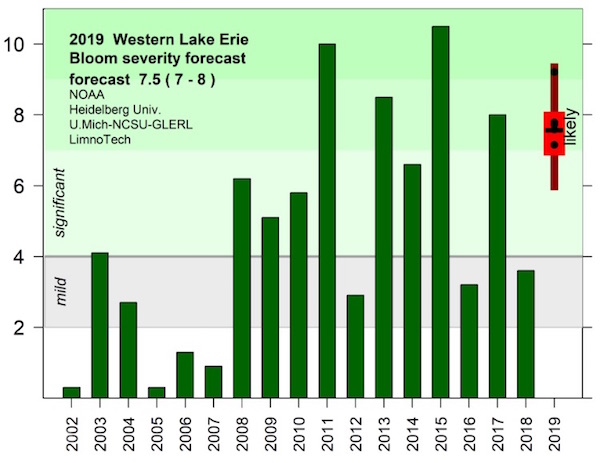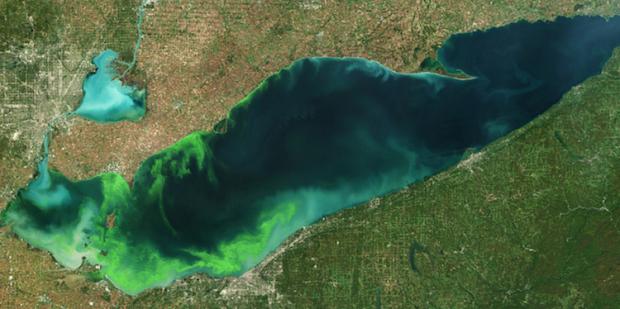The Skyway Distraction, the Water Quality Crisis
By early September, we will know whether or not the blue-green algae bloom underway in the western basin of Lake Erie is going to be as severe as the National Oceanic and Atmospheric Administration predicted in July.
The algae bloom in 2015 produced the liver toxin microcystin, which closed down the drinking-water supply for 400,000 people in and around the city of Toledo, Ohio, for several days. (Microcystin cannot be removed or neutralized by boiling.) The NOAA predicts a severity level of 7.5 for 2019 but also says that the upper range could hit 9 on its scale; the bloom in 2015 was a 10.
Blue-green algae have also bloomed this summer in Erie, Pennsylvania, just 80 miles from Buffalo on Lake Erie. Chautauqua County has closed beaches on Chatauqua Lake due to algal blooms, but its Lake Erie issues have so far been mainly sewage spills. Hundreds of inland lakes all over the Northeast have been hit, but the toll has been mainly on recreation, not drinking water.
Sadly, we probably know the answer already to the question of what September will bring: Lake Erie’s water quality is threatened, and it’s going to get worse. But until Buffalo faces the crisis Toledo faced four years ago, political engagement evidently won’t happen.

Experts on panels
Curiously, there is no panel of experts advising New York State what to do about the growing threat of toxic algae in Lake Erie.
In 2017, Governor Cuomo announced a 12-member Drinking Water Quality Council, headed by the state health commissioner, to address troubles in New York City and statewide. The state Legislature created the council after the horrifying contamination case in Hoosick Falls, near Albany, where the federal Environmental Protection Agency—and everybody else, it seems—dropped the ball on protecting citizens from an industrial chemical leaking into the water supply.
The Drinking Water Quality Council has not met since December 18, 2018.
However, the panel of experts on the future of the Skyway, which was announced in May, has already met. It announced in July that its members have narrowed the initial list of 100 entries to 20. Those plans will be discussed in upcoming public meetings, after which a list of 8 finalists will contend for the $100,000 prize. The winner will be announced the week of September 9.
A functional roadway that gets motorists from downtown Buffalo to a waterfront park in under four minutes, and that is tall enough to permit massive lake-going freighters to chug up the Buffalo river, will get rotten tomatoes from the panel of experts—it’s already been decided.
But the contestants still have to do their homework. Among the documents that the 20 semi-finalists have to address as they prepare their proposals for the anti-Skyway panel is a 2014 study by the New York State Department of Transportation, the Plausibility Review for the Removal of the Buffalo Skyway. That report concluded that the cost to remove the Skyway and to build all the required connectors—including a new Buffalo River bridge, a larger Michigan Street bridge, and adjustments to roadways to accommodate existing traffic flows—would cost between $1.25 to $1.38 billion.
Keeping the Skyway functioning for the next 25 years, the report found, would cost only $46 and $66 million.
As the state transportation staff operate on a long horizon. They are mandated to maintain (cheap) rather than replace (expensive) whenever possible. Thus nobody was surprised that the staff proceeded, after their 2014 review, to budget, bid out, and undertake the current $29 million repair project (which is supposed to be completed by this fall ) before getting word that elected officials were contemplating spending 20 times as much.
Notwithstanding the contrast between $1.2-$1.4 billion and $46 or $66 million, Buffalo-area news consumers already know the results that the panel of “independent experts” will deliver in September—because the conclusion has been announced.
One of the panelists is the leader of the Chicago-based Congress for a New Urbanism, which had previously published an essay demanding that the Skyway be torn down. Just to make sure, panelist and CNU Director Lynn Richard told the Buffalo News in June that she knows the Skyway, “and the Skyway must come down.”
The mayor of Buffalo, Byron Brown, favors real-estate development plans that have been proposed for the former Port of Buffalo, the land along Fuhrman Boulevard that is now the city’s green “front yard.” The stretch of bike paths and playgrounds bounded on the north by Times Beach Nature Preserve and on the south by the state park and marina has long been targeted by real-estate developers and by former staff of the Erie Canal Harbor Development Corporation, although public feedback has overwhelmingly favored passive parks rather than condominiums or other housing. Nevertheless, it is unlikely that any of the other panel members will buck US Representative Brian Higgins, state Senator Tim Kennedy, state Assembly Majority Leader Crystal Peoples, or Empire State Development chief Howard Zemsky, all of whom have voiced support for the “reimagine” project to make the Fuhrman Boulevard area another development tract.
As we’ve observed before, the population of the Buffalo area is not growing; the population of the city itself is still shrinking; the housing supply both within the city and the region is in oversupply; and any new Outer Harbor housing would probably diminish the value of existing housing, especially luxury housing, which new waterfront housing would almost certainly be.
Shortly after Labor Day, the news on the height of the summer algae bloom will be in. The news is already bad; the only question is whether the massive disruptions and dangerous conditions of 2015 in the Western basin of Lake Erie will be repeated this year, and whether the threat will drift eastward past Erie toward Buffalo.
Meanwhile, a $1 billion commitment to water quality in the face of upstream threats is on precisely no elected official’s website or campaign literature. We will check and see which elected officials endorse $1 billion for replacing the Skyway after the anti-Skyway report (and the $100,000 prize) is announced.
Bruce Fisher teaches at SUNY Buffalo State and is director of the Center for Economic and Policy Studies. His latest book, Where the Streets Are Paved With Rust: Essays From America’s Broken Heartland (The Public Books/Foundling Press 2018) is available at Talking Leaves Books and at foundlingspress.com.

